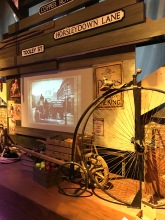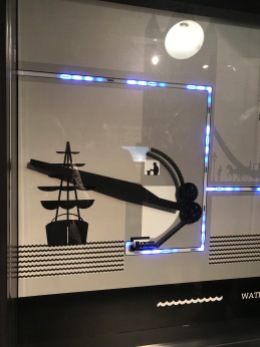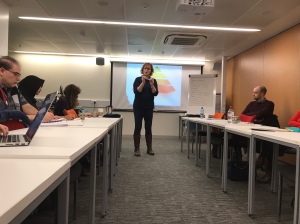
Defying gravity at Tower Bridge.
Tower Bridge is well worth a visit. A long visit at that!
Last weekend’s weather was dreary in London and we almost passed on the activity–a result of not knowing what we’d see inside and an entry fee of nearly 10 pounds sterling each. Missing this experience would have been quite a mistake!
Our visit to Tower Bridge and the museum that spans the overhead walkways and plunges into the engine rooms far below, lasted far longer than we’d expected.
Aongus and I explored had the surrounding area a bit first, after walking to Tower Bridge from Shoreditch. We’d found Dead Man’s Hole but had failed, for the time being, to locate the entrance to the “subway” that, once upon a time, facilitated walking by foot under the Thames from the north to the south bank.
The bridge lured us away from that pursuit.
We’d read about its gear system and, well frankly, at least one of us is a gear-head. Although we had expected see a steam engine, we had not expected to walk along the top of the bridge–the part that stay stationary when the drawbridge below is opened. But, happily, both sides of that walkway are part of the museum and open for exploring.
We spent a couple of hours studying the signs about bridge design and construction, this bridge’s history, and famous bridges from around the world (many of which I’ve visited). The mirror above the glass floor (of the walkway soaring high above the river and street) proved to be a delight. It’s a great source of entertainment and photo fun.
The museum also provides a short historic film, an animation of this bridge’s construction, and many alternative bridge designs that didn’t make the cut. There are informative plaques and drawings of the design that was ultimately constructed. There are also plaques and taped interviews with folks who built and operated the bridge.
The tour ended in the engine room on the south bank, where we learned about the giant steam engine that once powered lifts and lowerings of this formidable drawbridge.
We had hoped to visit the bascule chamber and witness the gigantic gears ourselves, even though we knew the drawbridge would not be opening that day. Unfortunately, the chamber isn’t open to the general public, so I’ll have to investigate how to get in with a group some day. It seems you can book in for a group to visit, but I’ll probably look for a group of engineers to join.
The photo gallery shows the surrounding area and parts of the museum itself.

Defying gravity at Tower Bridge.



 It’s a lot of work and a big team effort, but it has its benefits. What I am learning directly improves my teaching and it also helps me advise my colleagues, with whom I often discuss teaching strategies.
It’s a lot of work and a big team effort, but it has its benefits. What I am learning directly improves my teaching and it also helps me advise my colleagues, with whom I often discuss teaching strategies. As for breaking my naïve on the reputation and standing of UCL: QS’s most recent “world university rankings” ranked this institution seventh… in the world! Up there with MIT, Oxford, Harvard, and Cambridge.
As for breaking my naïve on the reputation and standing of UCL: QS’s most recent “world university rankings” ranked this institution seventh… in the world! Up there with MIT, Oxford, Harvard, and Cambridge.





































































